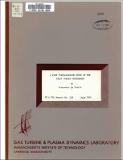Flow visualization study of the inlet vortex phenomenon
Author(s)
De Siervi, Francesca
Download16246371.pdf (5.203Mb)
Other Contributors
Massachusetts Institute of Technology. Gas Turbine and Plasma Dynamics Laboratory
Metadata
Show full item recordAbstract
The inlet vortex phenomenon was experimentally investigated in a water tunnel, using hydrogen bubble flow visualization techniques. Several inlet ambient flow combinations were studied, including an inlet and ground plane configuration in a known shear as well as an irrotational flow, and a double (twin) inlet configuration in an irrotational flow. This latter situation created a boundary layer free analogue of the ground plane and enabled investigation of inlet vortex formation in flow essentially free of ambient vorticity. The three dimensional inlet flow field and the vortex formation mechanisms were determined by marking material lines and observing their path and deformation as they are convected from a far upstream location into the inlet. Two basic mechanisms of inlet vortex generation were found. For flows possessing a vertical component of ambient vorticity, the amplification of this vorticity as the vortex lines are stretched and drawn into the inlet results in the formation of an inlet vortex. However, an inlet vortex does not require the presence of ambient vorticity to form. It can also be created in an irrotational flow, with an inlet in crosswind. In this situation, it is accompanied by a variation in circulation along the axial length of the inlet. The ratio of inlet velocity to upstream velocity is an important parameter in determining the generation of an inlet vortex for both mechanisms.
Description
July 1981 Includes bibliographical references (page 99)
Date issued
1981Publisher
Cambridge, Mass. : Gas Turbine & Plasma Dynamics Laboratory, Massachusetts Institute of Technology, [1981]
Series/Report no.
GT & PDL report ; no. 159